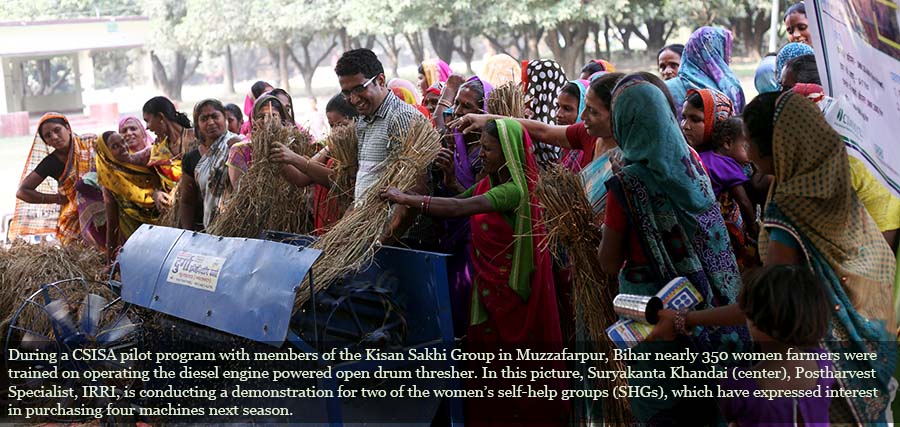Locally-Designed Thresher Meets Farmers’ Needs in Bihar
 In India, farmers with large landholdings from prosperous agricultural states like Punjab can often buy expensive and sophisticated machines for their farm operations. However, resource-poor farmers from states such as Bihar and Odisha may not be able to afford the same machines or services and, given that their landholdings may be considerably smaller, may have different needs. Farmers all along the spectrum of landholdings need to be able to access differently priced appropriate machinery based on their specific requirements. Machinery for mechanized threshing is one such example.
In India, farmers with large landholdings from prosperous agricultural states like Punjab can often buy expensive and sophisticated machines for their farm operations. However, resource-poor farmers from states such as Bihar and Odisha may not be able to afford the same machines or services and, given that their landholdings may be considerably smaller, may have different needs. Farmers all along the spectrum of landholdings need to be able to access differently priced appropriate machinery based on their specific requirements. Machinery for mechanized threshing is one such example.
For rice, mechanized threshing offers many advantages over manual threshing in terms of increased efficiency, reduced drudgery, cost and labor savings. Until recently, farmers in Bihar only had two options to choose from – the very large axial flow thresher that can cost up to Rs. 170,000 (US$ 2,700) after subsidy or the compact pedal-powered open drum thresher that has very low capacity and is difficult to operate for extended periods of time by women farmers, who are responsible for most threshing activities in India. The only medium-sized option was an electric motor powered open drum thresher available from other states, which was not effective as many farms in Bihar do not have reliable access to electricity.
“Farmers clearly needed a medium-sized, affordable, efficient and portable mechanical paddy thresher,” said Suryakanta Khandai, Postharvest Specialist, IRRI, who works for CSISA in Bihar. For most manufacturers and retailers in Bihar, however, importing such machines did not offer enough margin for profit. Cereal Systems Initiative for South Asia (CSISA) approached local fabricators in Bihar to assemble and sell these threshers.
Khandai added, “We wanted to build a locally-relevant product so understanding the shortcomings of the existing options was important. The pedal-powered open drum thresher, for example, was prone to accidents with most users complaining that their clothes would often get caught in the exposed mechanism. The existing models also lacked winnowing or bagging functions, which were included in the new design. Besides giving it wheels, we also decided to use a diesel engine to power the machine to allow for threshing in the field immediately upon cutting, which would help reduce losses.”
The result was the diesel engine powered open drum thresher, which was assembled in collaboration with the local fabricator Durga Engineering Works. CSISA provided them the technical specifications and also gave advice on developing a profitable business model around it.
“It was a work in progress so we also had to make modifications along the way. For instance, we found that the 4.5 hp diesel engine was scattering the grains too far so we had to attach an additional covering plate. This not only reduces the scattering loss but also made the machine safer to operate,” informed Khandai.
In the end though, the effort was worth it as both the fabricator and farmers can now reap its benefits. “Threshing with this machine saves me time and money. Labor is both expensive and unreliable. Hiring one person for a day costs Rs. 200 (US$ 3.2) and in this time one laborer can only manage threshing 3 katha of rice,” says Pawan Kumar Singh, a smallholder farmer and user of the machine from Samastipur, Bihar. “But with this machine, one person can thresh 5 katha in an hour at just Rs. 150 per hour (US$ 2.4).” Katha is a local unit of area where 22 katha equals approximately 1 acre. This means it costs Rs. 1,500 (US$ 24) to hire one person to manually thresh 1 acre of rice in 7 days. Using the diesel engine powered open drum thresher, however, the same area could be covered in just over four hours with a total cost of Rs. 660 (US$ 10.5).
Singh also highlights the fact that mechanical threshing can prevent substantial postharvest losses. “Manual threshing of rice involves repeatedly beating the bundle to separate the grain from the chaff. This results in unnecessary losses since the grain gets scattered everywhere. Further, if the bundle is not thoroughly threshed, farmers can suffer losses of nearly 2 to 4 kg of rice. But with the machine, your output is 100 percent.”
Durga Engineering Works sells the diesel engine powered open drum thresher for Rs. 30,000 (US$ 483) at an estimated profit of Rs. 11,000 per machine (US$ 177). They have already sold 15 pieces and are looking to expand distribution into other parts of India as well. The machine was recently certified by the Farm Machinery Training and Testing Institute (FMTTI) in Jharkand, which is a prerequisite for a machine to be subsidized by the government.
This article is authored by Ashwamegh Banerjee, Assistant Communications Specialist, CSISA.
Tags: Bihar, mechanization, Open Drum Thresher
